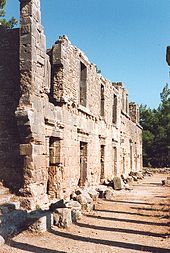Seleukia (Pamphylia)
Coordinates: 36 ° 52 ′ N , 31 ° 29 ′ E
Seleucia ( Greek Σελεύκεια ) was an ancient city in Asia Minor landscape Pamphylia . It has long been identified with a ruin site around 23 km north of present-day Side in Turkey , but recent research suggests that the ruins are those of the ancient city of Lyrbe ( Λύρβη ) and not those of Seleukia, perhaps 15 km west of Side.
history
Seleukia is known by name from several geographical works of antiquity, but the history of the city is largely in the dark. Their name indicates a Seleucid foundation, possibly directly by Seleukos I Nicator . It is made around 300 BC. Have been founded.
archeology
The ancient city with the best-preserved agora (market square) is difficult to access and spared modern settlement in the middle of a dense pine forest. The site was explored by Istanbul archaeologists in the early 1970s, who secured an Orpheus mosaic and a bronze statue of Apollo as the most art-historical finds of the city - today in the Museum of Antalya .
The foundations of a Byzantine church - in the immediate vicinity of the room of the Orpheus mosaic, which is surrounded by four Ionic columns on the north side of the market square - show that the place was still or at least inhabited again in the Middle Ages. Due to its strategically favorable plateau location on a mountain slope sloping to the west, the city only needed to be protected in the south by a city wall that is still up to a height of 9 meters.
The imperial agora rests in the west on huge substructures with barrel vaults, which were used as magazines, in order to gain even terrain. In the west rise eight two-storey shop buildings, the preservation of which is only known from Pompeii or Herculaneum . To the south there is a small odeion .
A few meters north of the market square, a small podium temple with a former four-column pronaos is well preserved. Further to the west, now overgrown, large thermal baths can be seen, the remains of massive marble cladding that speak for the original wealth of the city. Later renovations were only carried out with thin slabs of pressed marble dust.
literature
- Jale İnan : Toroslar'da bir ancient kent: Lyrbe? - Seleukeia? = An ancient city in the Taurus Mountains . Arkeoloji ve Sanat Yayinları, Istanbul 1998. ISBN 975-7538-93-0 .
- Wolfram Martini : Seleukeia [4]. In: The New Pauly (DNP). Volume 11, Metzler, Stuttgart 2001, ISBN 3-476-01481-9 .






